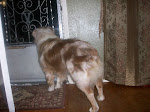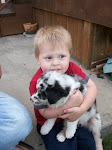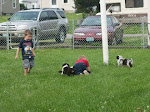
This picture is of Maggie, Grandson Levi's dog with her two puppies.
THE WORKING DESCRIPTION OF THE AUSTRALIAN SHEPHERD
Adopted by the Stockdog Committee of the Australian Shepherd Club of America on March 12, 2006
Introduction
The Australian Shepherd was developed in the 19th and 20th centuries as a general purpose ranch and farm dog in the American West, where a tough, enduring, versatile stockdog with an honest work ethic was required. His usual work included moving very large herds of sheep and cattle from summer to winter grazing grounds and back, flushing range cattle out of heavy brush, and moving livestock in tight quarters such as chutes and alleys. These kinds of jobs are still where Australian Shepherds excel and are most valued.
The Australian Shepherd is categorized as one of the Loose-Eyed breeds of stockdogs. He is a confident, authoritative worker with a unique style that differs from Strong-Eyed breeds. He is agile, upright and close-working, and exhibits these distinctive traits while maintaining the ability and versatility to control all types of livestock in an efficient and deliberate manner. The Australian Shepherd excels at controlling large and/or slow-moving flocks of sheep and herds of cattle, and is highly regarded for his superior ability to effectively manage livestock in tightly confined spaces. The Australian Shepherd is powerful and intense by nature, easily learning the appropriate force and distance needed for the type of livestockbeing worked. Using a loose-eyed approach to stock, a working Australian Shepherd will often display wear, grip, and/or an authoritative bark, as well as eye when necessary, to handle his stock.
Wear
The Australian Shepherd's wear in smooth, balanced, and ground-covering as the dog moves easily from side to side at the back of the stock, keeping his herd or flock together and moving forward. This is a very natural movement for an Australian Shepherd, and one that he can continue doing for hours at a time.
Grip
The Australian Shepherd will only use grip to move reluctant or challenging stock. The ideal Australian Shepherd naturally grips at both the head and heel, coming in low and hard on the heels to move cattle, or going to the head and gripping the nose or poll to turn an animal back to the herd.
Bark
The Australian Shepherd may bark to move stock or to face a challenge. His bark is conservative and should be authoritative when used. While the Australian Shepherd's grip typically affects a single animal, his bark can influence a whole herd, and is most effective when stock has come to a standstill such as in crowded alleyways. The Australian Shepherd's bark is particularly useful when gathering cattle from thick brush.
Eye
Since the Australian Shepherd is a loose-eyed working dog, he prefers to use his authority and presence to move livestock. However, if challenged, he may use eye in a direct and deliberate way until the challenge is over.
© Australian Shepherd Club of America





















